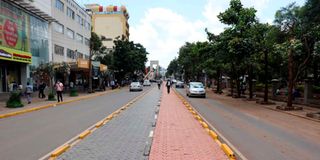Public project design should focus on users

A section of Muindi Mbingu Street in Nairobi's CBD in this picture taken on March 31, 2021 after it was upgraded by Nairobi Metropolitan Services in the ongoing city face-lift projects.
Statistics from the Africa Development Bank show that roads are the main means of transport, accounting for the movement of 80 per cent of goods and 90 per cent of passengers.
Therefore, Kenya’s infrastructure developments, especially roads and highways, are supposed to not only ease movement but also enhance the productivity of the population.
The same data demonstrates that 53 per cent of roads are unpaved, limiting public access to economic opportunities and trade.
Further, less than half of Africa’s rural population has access to at least one all-season road. People are not able to go to school, seek healthcare, or access the transport corridors they need for movement.
There is also poor access to secure energy, reliable communication systems, adequate sanitation and affordable housing.
Human-centred design is increasingly embraced globally as a way of ensuring that infrastructure meets people where they are. Road and highway building in Kenya is a case study of ways in which design continues to miss essential human-centred components.
Perilous turns
Kenyan road users, be they pedestrians, cyclists or motorists, are routinely blamed for poor road behaviour, without consideration for the fact that road and traffic signs, signals, lights and more are most often not present, or functional.
Hazardous places are not cordoned off, and perilous turns lack mirrors and adequate signage. The overall lack of lighting in places under construction is another repeat complaint, leading drivers to use brighter light settings, compromising visibility for other road users. Lack of light makes roads a security hazard for all.
Human health
Dust is also an obstacle to visibility, and construction dust is a key air and environmental pollutant, contributing significantly to poor plant, animal and human health. Many of these issues are avoidable through human-centred design by first considering that if infrastructure projects centre the needs of their most at-risk users, they will be automatically safe enough for everyone else.
Kenyan road building must prioritise the needs of pedestrians, especially children, the elderly and persons with disabilities. Each project manager has to refer to research to make sure a good baseline of people’s needs and values are met at the design phase.
Secondly, prompt and clear communication is essential. Adequate, accessible, timely communication about expected delays must be done to mitigate small problems quickly, before they become big ones.
Infrastructure delivery is a key campaign manifesto item during elections in Kenya. It is high time elected officials and relevant state agencies played their part in the ethical enforcement of relevant policies and regulations.
This would ensure the construction of roads, buildings and more is as friendly to everyone as possible, besides making sure public and private construction works are a more accountable sector, for the good of all.
The writer is a policy [email protected]





